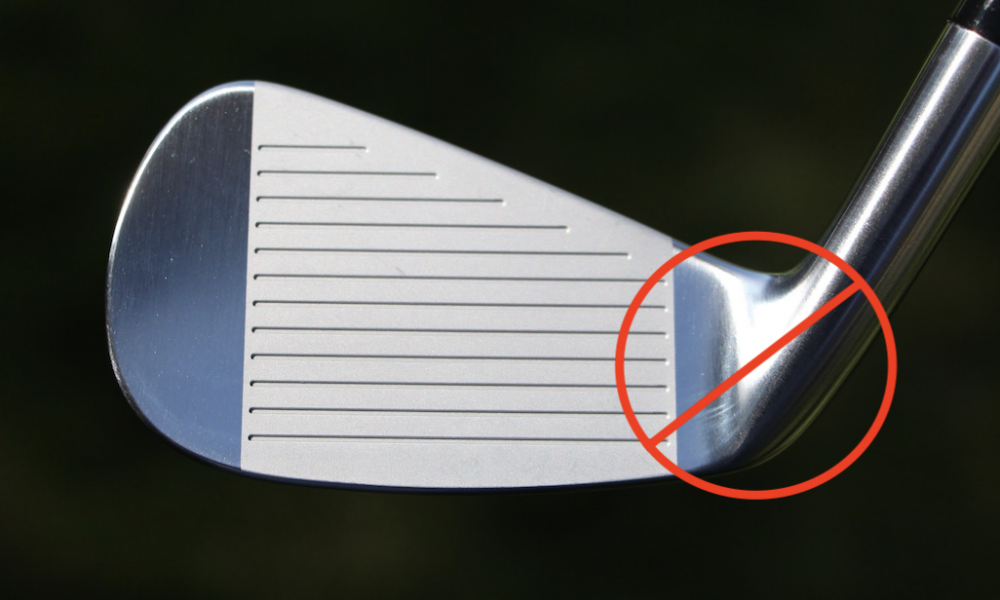To stop shanking the golf ball, focus on proper alignment and maintain a steady head position. Practice a consistent swing path.
Shanking the golf ball can be frustrating for golfers. It often occurs when the clubface meets the ball at an awkward angle. Proper alignment is crucial to prevent this mishap. Ensure your feet, hips, and shoulders are parallel to the target line.
Keeping your head steady throughout the swing can also help. Avoid excessive movement which can alter your swing path. Consistent practice and focusing on these fundamentals can significantly reduce shanks. Remember, patience and repetition are key. With dedication, you can improve your game and enjoy a more consistent performance on the golf course.
Credit: www.quora.com
Common Causes
If you’re struggling with shanking the golf ball, understanding the common causes can help. Fixing these issues can improve your game significantly. Let’s dive into the main culprits behind those frustrating shanks.
Grip Issues
Your grip plays a crucial role in hitting the ball correctly. A poor grip can lead to shanking. Ensure your hands are placed properly on the club. A weak grip can cause the clubface to open. This leads to off-center hits.
Check these grip tips:
- Hold the club with a neutral grip.
- Ensure your hands are neither too tight nor too loose.
- Position your left thumb along the shaft.
- Wrap your right hand over the left thumb.
Stance Problems
Stance affects how you strike the ball. Incorrect stance leads to shanking. Make sure your feet are shoulder-width apart. Keep your weight balanced between your heels and toes.
Follow these stance guidelines:
- Stand with your feet shoulder-width apart.
- Bend slightly at the knees.
- Distribute your weight evenly.
- Align your body parallel to the target line.
Swing Path Errors
The path of your swing can cause shanking. An outside-in swing path is a common error. This path leads to the clubface hitting the ball’s heel.
Correct your swing path by:
| Common Error | Correction |
|---|---|
| Outside-in swing | Swing from inside-out |
| Clubface open | Square the clubface |
Practice these tips to stop shanking. Improve your grip, stance, and swing path. You’ll see better results on the course.
Proper Grip
One of the keys to stopping shanking the golf ball is maintaining a proper grip. Your grip on the club affects your swing and ball direction. Let’s dive into key aspects of a proper grip: neutral grip, pressure points, and finger position.
Neutral Grip
A neutral grip balances control and power. It helps keep the clubface square at impact. Here’s how to achieve a neutral grip:
- Hold the club with your left hand first.
- Ensure the club runs diagonally across your palm.
- Wrap your fingers around the club.
- Your thumb should point down the shaft.
- Place your right hand below your left hand.
- Interlock or overlap your fingers.
Pressure Points
Proper grip pressure is vital. Too tight or loose can cause shanking. Focus on these pressure points:
| Hand | Pressure Points |
|---|---|
| Left Hand | Base of the fingers, not the palm. |
| Right Hand | Fingers and not the palm. |
Keep a firm but relaxed grip. Imagine holding a tube of toothpaste without squeezing it.
Finger Position
Finger position impacts control and feel. Correct finger placement aids accuracy:
- Place the club in the fingers, not the palms.
- Ensure the left thumb fits snugly in the lifeline of the right hand.
- Interlock or overlap your fingers for a secure hold.
- Keep your fingers wrapped around the club, not too tight or loose.
Following these tips on grip can greatly reduce shanking. Practice these steps regularly. Your game will improve with time.
Stance And Alignment
Shanking the golf ball can be frustrating. Your stance and alignment play a crucial role in avoiding it. By focusing on these fundamentals, you can improve your swing and eliminate shanking.
Foot Position
Start with your feet shoulder-width apart. This stance provides balance and stability. Ensure your toes point slightly outward. This helps maintain proper alignment through your swing.
| Foot Position | Effect |
|---|---|
| Shoulder-width apart | Provides balance |
| Toes slightly outward | Maintains alignment |
Shoulder Alignment
Align your shoulders parallel to your target line. This ensures your swing path is correct. Keep your shoulders level to avoid over-rotation. Proper shoulder alignment helps control the clubface.
- Shoulders parallel to target line
- Level shoulders
- Control clubface
Ball Position
Place the ball in line with the instep of your front foot. This positioning ensures solid contact. Adjust the ball position slightly for different clubs. A consistent ball position helps maintain a steady swing path.
- Align ball with front foot instep
- Adjust for different clubs
- Maintain steady swing path
Swing Mechanics
Swing Mechanics are crucial to playing a good round of golf. Many golfers struggle with shanking the ball. Improving your swing mechanics can help you avoid this issue. Let’s explore three key areas: the Backswing, the Downswing, and the Follow-Through.
Backswing Tips
During the backswing, maintain a strong posture. Keep your spine straight and your knees slightly bent. Your arms should be relaxed and your grip firm but not tight. Here are some additional tips:
- Ensure a smooth takeaway.
- Rotate your shoulders fully.
- Keep your head steady.
These tips help set up a solid foundation for your swing.
Downswing Focus
Focus on a controlled downswing. Start by shifting your weight to your front foot. Your hips should rotate toward the target. Keep your eyes on the ball and your arms straight. Consider these points:
- Lead with your hips.
- Keep your wrists firm.
- Accelerate through the ball.
Following these steps ensures a powerful and accurate shot.
Follow-through
A proper follow-through completes your swing. Your body should face the target. Your weight should be on your front foot. Club should continue its path naturally. Focus on these elements:
- Maintain balance.
- Hold your finish position.
- Relax your grip.
These actions will help you finish your swing smoothly and effectively.
Mental Approach
The mental approach is crucial for golfers aiming to stop shanking the ball. A calm mind helps improve focus and consistency. Addressing mental aspects can significantly improve your game.
Stay Relaxed
Staying relaxed on the golf course is essential. Tension can lead to poor shots.
- Practice deep breathing exercises.
- Take a moment to clear your mind before each shot.
- Visualize a successful shot to calm nerves.
Relaxed muscles allow for smoother swings. This helps prevent shanks. Remember, a relaxed mind leads to a relaxed body.
Focus Techniques
Improving focus can reduce the chances of shanking the ball.
- Set specific, achievable goals for each round.
- Break down your swing into simple steps.
- Focus on one aspect of your technique at a time.
Avoid overthinking. Concentrate on the target, not the mechanics. Short, clear mental cues can enhance focus.
Routine Development
Developing a consistent routine helps build confidence and reduces errors.
| Element | Action |
|---|---|
| Pre-Shot Routine | Align clubface, set stance, visualize shot |
| Practice Swings | Take 1-2 swings focusing on form |
| Shot Execution | Commit to the shot, execute smoothly |
Stick to your routine for every shot. This builds muscle memory and reduces shanks. A solid routine creates consistency.
Practice Drills
Shanking the golf ball can be frustrating. The good news is, with the right practice drills, you can eliminate this issue from your game. Here are some effective drills to help you stop shanking the golf ball.
Gate Drill
Use two alignment sticks. Place them slightly wider than your club head. Position them parallel to your target line.
- Set up to the ball between the sticks.
- Take slow swings to avoid hitting the sticks.
- Gradually increase your swing speed.
This drill helps you maintain the correct swing path. It prevents the club from moving too far inside or outside.
Impact Tape
Apply impact tape to your clubface. This will show you where you are striking the ball.
| Impact Location | Adjustment Needed |
|---|---|
| Heel | Move closer to the ball |
| Toe | Move farther from the ball |
Make small adjustments to your stance based on the impact tape feedback. This helps you find the center of the clubface more consistently.
Mirror Work
Use a mirror to check your swing positions. Focus on your setup, backswing, and follow-through.
- Stand in front of a mirror.
- Take your golf stance.
- Perform slow-motion swings.
Compare your positions to those of professional golfers. Correct any flaws you see in your swing.
These practice drills are designed to help you stop shanking the golf ball. Consistent practice will lead to improved results.
Equipment Check
Shanking the golf ball can be frustrating. An equipment check might help. The right gear can make a big difference in your game. Let’s explore three key areas: Club Fitting, Shaft Flexibility, and Grip Size.
Club Fitting
A properly fitted club can improve your swing. Visit a professional club fitter. They will measure your height, arm length, and swing speed. This ensures your clubs are the right length and weight. Fitted clubs can help you avoid shanks.
Shaft Flexibility
The shaft flexibility affects how the club feels during your swing. There are different flex types: extra stiff, stiff, regular, senior, and ladies. Choose a shaft that matches your swing speed. A flexible shaft for a slower swing, and a stiffer shaft for a faster swing. The right flex can help you hit the ball straighter.
Grip Size
The right grip size is crucial. A grip that is too small can cause over-gripping. A grip that is too large can hinder wrist action. Measure your hand size to find the right grip. A good grip size helps you control the club better. This can reduce shanks significantly.
| Club Fitting | Shaft Flexibility | Grip Size |
|---|---|---|
| Height | Extra Stiff | Over-gripping |
| Arm Length | Stiff | Wrist Action |
| Swing Speed | Regular | Hand Size |
| Club Length | Senior | Control |
| Club Weight | Ladies | Accuracy |
- Measure your height, arm length, and swing speed.
- Choose a shaft with the right flexibility.
- Find the grip size that fits your hand.

Credit: m.youtube.com
Professional Help
Sometimes, stopping the shank requires professional assistance. Expert guidance can transform your golf game. Let’s explore how lessons, video analysis, and feedback can help.
Lessons
Golf instructors offer structured lessons. They focus on your unique swing. You get personalized tips and drills. These sessions can correct bad habits. Regular lessons build confidence and consistency. You’ll see improvement in your overall game.
Video Analysis
Video analysis captures your swing in detail. Professionals review the footage with you. They pinpoint exact issues causing shanks. You see what needs fixing. Visual feedback helps you understand better. It makes learning more effective and enjoyable.
Feedback
Constructive feedback is vital. Instructors provide specific advice. They suggest simple, actionable steps. Follow their guidance for steady improvement. Feedback keeps you on track. It ensures you’re practicing correctly and not reinforcing errors.

Credit: www.golfwrx.com
Frequently Asked Questions
How To Quit Shanking The Golf Ball?
Grip the club lightly and ensure proper hand placement. Keep your stance balanced and aligned. Focus on striking the ball’s center. Practice a smooth, controlled swing. Regularly check your posture and alignment.
How Do You Fix A Shank In A Golf Swing?
To fix a shank, focus on proper grip and stance. Keep weight balanced and maintain a smooth swing path. Rotate your body, not just your arms.
How To Avoid Shanking Irons?
To avoid shanking irons, maintain a proper grip and stance. Focus on hitting the ball’s center. Keep your weight balanced and swing smoothly. Practice regularly to improve consistency.
Why Do I Keep Shanking The Ball Right?
You may be shanking the ball right due to poor alignment, an open clubface, or an outside-in swing path. Ensure proper grip, stance, and swing mechanics to correct this issue.
Conclusion
Mastering the techniques to stop shanking the golf ball can transform your game. Practice consistently and stay patient. Focus on grip, stance, and swing adjustments. These tips will help you enjoy golf more and lower your scores. Remember, improvement takes time, but dedication pays off.
Happy golfing!





